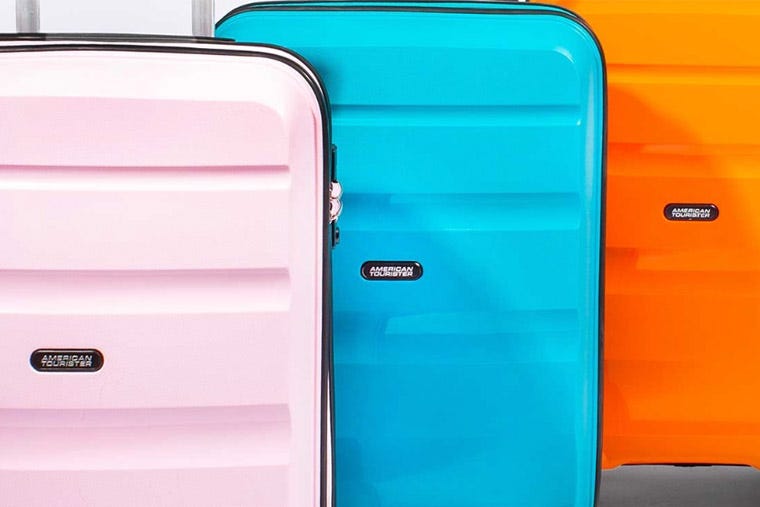

Luggage Buying Guide
A helpful guide to help you find the perfect suitcase to suit your needs.
There’s so many different types of luggage out there, it can be hard to decipher which is best for you.
This handy buying guide will help you to understand the different elements that make up your luggage and ultimately to work out exactly what you need to fit your personal requirements.
Wheels
The type of wheels you choose for your suitcase will have a big impact on its overall manoeuvrability. Generally, most suitcases will have either 2 or 4 wheels, some can even have up to 8.


2 Wheels
Suitcases that have 2 wheels tend to be referred to as Upright Suitcases. As there are fewer wheels they tend to be slightly larger which makes them perfect for manoeuvring across rougher surfaces such as pavements, and for pulling up and down curbs.
Upright suitcases tend to lend themselves fairly well to business travellers as they are much more versatile over a range of travel situations.


4 Wheels
Suitcases with 4 wheels tend to be referred to as Spinner Suitcases. Having 4 wheels makes them much easier to manoeuvre over smooth floors such as airports and train stations.
Suitcases with 4 wheels are ideal when travelling abroad as they can easily be transported through the airport, fairly effortlessly, giving you one less stress or worry.


8 Wheels
Some suitcases have 8 wheels - these are pretty much identical in features to a 4 wheel case, however, they will have much better control and manoeuvrability due to the additional wheels.
8 wheel suitcases are also much more practical when travelling on different floor textures than other suitcases as they have much more superior levels of manoeuvrability.
Locks
It is really important that you lock your suitcase when travelling, especially via aeroplane, as this will prevent the case from opening whilst being loaded/unloaded therefore making sure all of your belongings reach their destination safely.
TSA Approved Locks
Occasionally, when luggage is inspected before being loaded onto a plane, it needs to be opened by staff at the airport - no matter whether your case is locked or not.
TSA approved locks allow airport security agents to open your suitcase using a special tool, meaning that they do not have to force entry. This means that they can then easily inspect your luggage and re-lock your suitcase without any unnecessary damage.
All TSA approved locks contain a Red Diamond - a universal symbol which allows you to identify if your suitcase lock is TSA approved.
Some suitcases come with built in TSA approved locks - it is important to check if your case has one of these to save you having to purchase an additional lock before travelling.


Combination Locks
Combination locks require a numerical code to be set in order for the lock to open. Combination locks are extremely secure and pretty much immune to picking as anyone trying to access your suitcase would need to know your code - this will give you extra peace of mind once you have said goodbye to your case at the check-in desk.
The only downside to using a combination lock on your suitcase is that you will need to remember the code that you have set in order to open your case and access your belongings. Perhaps not the best option if you are generally fairly forgetful!


Key Locks
Key locks or padlocks require a key to open and access your suitcase. Locks that require a key are much easier to use as all you need to do is carry your key around with you rather than have to remember a numerical code like you would with a combination lock. The only downside to this is that they are also a lot easier to break into as thieves would be able to pick or cut the lock fairly easily.
Material
The material used to make your suitcase will make a big difference to the weight, internal storage space and durability of your luggage. Most luggage comes in either hard or soft materials, each having their own advantages;


Hardshell
If you are travelling overseas on a regular basis and need a suitcase which is built for durability, then a hardshell suitcase is probably the best choice for you.
The harder outside shell makes the case a lot more robust than soft luggage which will help to give your belongings additional protection from the wear and tear of being loaded, unloaded, and sliding around the plane hold.
The hard outers also make them a lot more water resistant than fabric alternatives meaning that your belongings will be better protected from any potential leaks or spills that may occur during your journey.
Pros:
✔ Better protection for fragile belongings
✔ Higher water resistance
✔ Tend to be more modern designs and colour options
✔ Often have more wheels for added maneuverability
Cons:
✗ Can be difficult to store due to the hard exterior
✗ More susceptible to minor damage such as scuffs and scratches


Softshell
If you tend to travel a lot in the car or on the train, a softshell suitcase is probably your best option.
The softer exterior makes them a lot more pliable - they can be squeezed easily into the boot or overhead luggage rack and are less susceptible to minor damage from doing so such as scuffs and scratches. They are also much easier to store when they aren’t being used as they tend to take up a lot less space than a bulky, hardshell alternative.
Soft suitcases can also be useful when you have a specific weight limit for your baggage as the fabric outer means they tend to be a lot lighter than hardshell cases. They also tend to have much more expandable options which are especially great if you are travelling with children and need to fit a lot in there.
Pros:
✔ Soft exteriors make them easy to store when not in use
✔ Lighter in weight and much more room for expansion
✔ Often have additional outer pockets which are handy for quick access
Cons:
✗ Less protection for fragile belongings
✗ Fabric exterior is more susceptible to water damage
Size/Weight
If you are travelling via Airplane, there is a strong possibility that you will have size or weight restrictions put in place for your luggage by your airline.
With regards to check-in luggage, these tend to just have a weight restriction rather than size. You will need to make sure that you have weighed your case before you get to the airport to save any additional charges at the check-in desk.
It’s really easy to weigh your suitcase once it is packed; you can either use your regular weighing scales or a specific luggage scale.
Carry-on luggage tends to have much tighter restrictions on size and this can vary a lot from airline to airline.
It is really important that you measure your carry-on case before travelling as you could face additional charges once you get to the airport if the case is too big to take on to the plane and has to be checked in.
Use our handy cabin luggage size guide to determine if your hand luggage meets the criteria set by your chosen airline.













